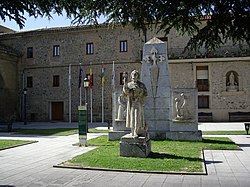Santo Domingo de la Calzada | |
|---|---|
Municipality | |
| Coordinates: 42°26′31″N2°57′9″W / 42.44194°N 2.95250°W | |
| Country | |
| Autonomous Community | |
| Province | La Rioja |
| Comarca | Santo Domingo de la Calzada |
| Government | |
| • Mayor | Agustín García Metola (PSOE) |
| Area | |
• Total | 40 km2 (15 sq mi) |
| Elevation (AMSL) | 641 m (2,103 ft) |
| Population (2024) [1] | |
• Total | 6,348 |
| • Density | 160/km2 (410/sq mi) |
| Time zone | UTC+1 (CET) |
| • Summer (DST) | UTC+2 (CEST (GMT +2)) |
| Postal code | 26250 |
| Area code | +34 (Spain) + 941 (La Rioja) |
| Website | Town Hall |
Santo Domingo de la Calzada is a municipality in La Rioja, Spain, situated on the banks of the Oja River.








